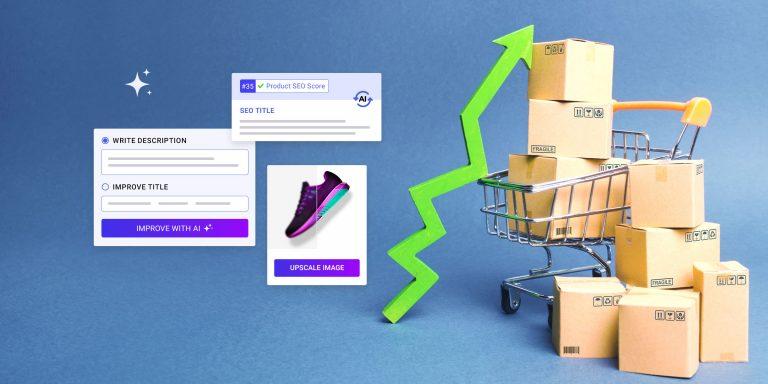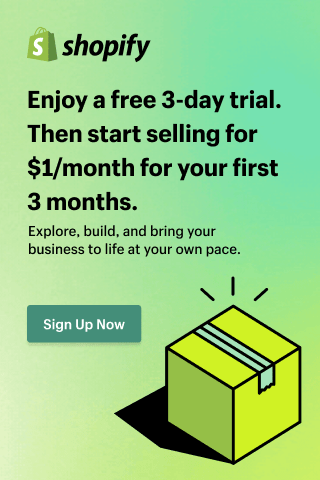Starting an online store can be an awesome adventure. But for many beginners, the idea of managing inventory, storing products, handling packaging, and organizing shipping, can be daunting.
The good news? You don’t need to manage any inventory to run a successful online business in 2024. In fact, many online retailers today are skipping inventory management entirely and opting for smarter, leaner ways to sell products.
This guide will walk you through everything you need to know about starting an online store without ever dealing with inventory. From choosing the right business model to finding suppliers, this is your roadmap to setting up a store that operates seamlessly without the headaches of stock management.
Table of Contents
Why start an online store without inventory?
If you’re still wondering why starting an online store without managing inventory might be the way to go, here are a few reasons:
- Lower startup costs: Traditional retail businesses require you to buy products upfront, which can be costly. But without inventory, you don’t have to worry about upfront investments in stock.
- No storage or warehousing: Not managing physical products means no need for a warehouse or worrying about space limitations.
- Reduced risk: There’s no fear of unsold products. You only purchase items when customers place an order, ensuring that your products don’t sit unsold in storage.
- Flexibility: Without inventory constraints, you can easily scale your store, adding or removing products based on trends, demand, and customer preferences.
- Location independence: Without the need to manage a physical stockpile, you can run your store from anywhere in the world, as long as you have an internet connection.
Popular business models for online stores without inventory
There are several business models that allow you to run an online store without managing inventory. Let’s take a look at some of the most popular ones:
1. Dropshipping
Dropshipping is one of the most popular business models for people who want to start an online store without holding inventory. In dropshipping, you partner with suppliers who keep and ship the products for you. When a customer places an order on your website, you pass that order to the supplier, who fulfills it on your behalf.
Now, you know this entire blog is all about dropshipping and ecommerce, so, for more about dropshipping, just browse through our hundreds of articles. For example, you can start with this article about the 44 Most Popular Questions About Dropshipping.
Benefits of dropshipping:
- Low startup costs: You don’t need to buy products in bulk.
- No need for warehousing: Suppliers handle the storage, packaging, and shipping.
- Flexibility: You can offer a wide variety of products without committing to any specific stock.
How to start dropshipping:
- Choose a niche: Focus on a product category with demand, such as electronics, fashion, or fitness gear.
- Find reliable suppliers: Use platforms like AppScenic or Printify to find suppliers who can fulfill your orders.
- Set up an online store: Use ecommerce platforms like Shopify or WooCommerce to create your online store.
- Market your products: Drive traffic to your store using digital marketing techniques like SEO, social media, and paid ads.
Read more: How to Launch a Dropshipping Business in 6 Easy Steps
2. Print on Demand (POD)
Print on Demand is similar to dropshipping, but instead of selling pre-made products, you create custom designs that are printed on items like t-shirts, mugs, or phone cases. When a customer orders a product, the design is printed, packaged, and shipped directly to them by the POD provider.
Benefits of Print on Demand:
- No upfront cost for inventory: You only print products after a sale is made.
- Customization: You can create unique designs, making your store stand out.
- Variety: You can offer a wide range of products, from clothing to accessories and home décor.
How to start Print on Demand:
- Choose a platform: Use POD services like Printify, Printful, or Gelato that integrate with your online store.
- Create your designs: Either create your own designs or hire a designer to produce designs for your store.
- Set up your store: Similar to dropshipping, use platforms like Shopify or Etsy to display and sell your products.
- Promote your designs: Use social media, influencer marketing, or email marketing to showcase your unique designs.
If you want to know more about POD, check out this extensive guide on how to start a POD business in 2024.
3. Affiliate marketing
In affiliate marketing, you don’t sell products directly through your store. Instead, you promote products from other companies and earn a commission for each sale made through your referral links. While you don’t manage any inventory, affiliate marketing allows you to earn money by recommending products from other businesses.
Benefits of affiliate marketing:
- No customer service or order fulfillment: The merchant handles all product shipping and customer issues.
- Passive income potential: Once you’ve built traffic and a loyal following, you can earn commissions without ongoing active work.
- Scalability: You can promote an unlimited number of products without needing inventory or capital.
How to start affiliate marketing:
- Choose a niche: Select a product category that aligns with your website or blog.
- Join affiliate programs: Sign up for affiliate programs from companies like AppScenic, Amazon Associates, ShareASale, or Rakuten.
- Promote the products: Create content like blog posts, reviews, or tutorials to promote the affiliate products and drive traffic using your unique referral link.
Read more: Dropshipping vs. Affiliate Marketing: Which One is Right for You?

4. Digital Products and Services
Not all ecommerce businesses need to sell physical products. You can sell digital products and services directly through your website without managing inventory. These digital products can range from educational courses, eBooks, and digital artwork to online services like tutoring or consulting.
Benefits of selling digital products:
- No physical product inventory
- Higher profit margins with no production costs
- Scalable business model that allows you to sell multiple digital products
How to start selling digital products:
- Choose a niche: To start selling digital products, opt for a niche, whether it’s educational courses, digital art, or eBooks.
- Build your content: Create the content and host it on platforms like Shopify or WordPress.
- Sell your products: Market your digital offerings through social media, email campaigns, or collaborations with influencers.
5. Fulfillment by Amazon (FBA)
Fulfillment by Amazon (FBA) lets you run an ecommerce business without the need to handle inventory. You send products directly to Amazon’s fulfillment centers, and they manage the rest, inventory storage, packaging, shipping, and even customer service. This model offers access to Amazon’s vast customer base and fast shipping services.
Benefits of FBA:
- Access to Amazon’s marketplace and customer base
- Amazon handles fulfillment and customer service
- No need for you to manage logistics directly
How to start with FBA:
- Open an Amazon Account: To start using Amazon FBA, set up a Seller Central account with Amazon.
- Find products: Source your products, send them to Amazon’s fulfillment centers, and list them on the platform.
- Promote your products: Use Amazon’s built-in advertising tools to promote your products to millions of potential customers.
6. Third-Party Logistics (3PL)
A third-party logistics (3PL) company offers services similar to dropshipping, but you still manage your own products. A 3PL handles everything from storing your inventory to packing and shipping your products to customers. This is a great option for businesses that are scaling up but don’t want the hassle of running their own warehouse.
Benefits of 3PL:
- No need to manage your own warehouse
- Outsourced logistics, including packing and shipping
- More flexibility in sourcing products
How to start with 3PL:
- Research: To start with a 3PL service, research companies that align with your business needs, such as ShipBob or FedEx Fulfillment.
- Send inventory: Once you’ve chosen a 3PL provider, send your inventory to their warehouses.
- Grow your store: The shipping providers will handle the shipping and logistics while you focus on growing your customer base and managing sales.
Key steps to start an online store without managing inventory
Ready to get started? Here’s a detailed guide to setting up an inventory-free online store.
1. Choose a niche
Before you build your store, it’s essential to choose a niche. The niche you select will determine your target audience, product offerings, and marketing strategy. Consider selecting a niche based on your interests, market demand, or current trends.
Some profitable niches include:
- Fitness equipment and apparel
- Home décor and kitchen accessories
- Eco-friendly products
- Tech gadgets and accessories
- Pet supplies
2. Find a supplier or partner
Whether you choose dropshipping, print on demand, or affiliate marketing, finding the right supplier is critical. For dropshipping and POD, ensure that your supplier offers high-quality products, reasonable pricing, and fast shipping. Look for reviews or request product samples before committing to a supplier.
Here are some platforms where you can find suppliers:
- AppScenic: Our platform offers a wide selection of high-quality products from reliable suppliers in the USA, EU or UK, and integrates with popular ecommerce platforms like Shopify or WooCommerce.
- Printful or Printify: Great for POD services with seamless integration into Shopify, WooCommerce, and Etsy.
Read more: How to Identify a Reliable Supplier for Your Dropshipping Niche
3. Set up your online store
Now that you have a niche and suppliers in place, it’s time to build your online store. Many ecommerce platforms make it easy to create a professional-looking store without needing coding or technical expertise.
Some popular ecommerce platforms include:
- Shopify: Known for its user-friendly interface and robust dropshipping features.
- WooCommerce: A WordPress plugin that allows you to create an online store on your existing website.
- Etsy: Great for print on demand or handmade items.
4. Create and optimize your store
Once your store is set up, focus on designing a user-friendly layout that appeals to your target audience. Ensure your product pages are optimized for conversions by including:
- Clear product descriptions
- High-quality images
- Customer reviews and testimonials
- Transparent shipping and return policies
Don’t forget to optimize your store for search engines (SEO) to drive organic traffic.
Read more: Advanced SEO Strategies for Dropshipping Websites (Easy to Apply)
5. Market your store
With your store up and running, the next step is to attract customers. Here are some ways to market your store effectively:
- Social Media Marketing: Create profiles on Instagram, Facebook, and TikTok to promote your products and engage with your audience.
- Content Marketing: Start a blog or YouTube channel to share valuable content related to your niche and drive traffic to your store.
- Paid Advertising: Invest in targeted ads on Google, Facebook, or Instagram to reach potential customers quickly.
- Email Marketing: Build an email list and send newsletters to keep your audience engaged and informed about new products or promotions.
Read more: How to Run Ecommerce Social Media Campaigns Effectively
Ready to build a successful store without inventory?
Starting an online store without managing inventory is not only possible but also a smart way to minimize risk, reduce costs, and focus on scaling your business. Whether you choose dropshipping, print on demand, or affiliate marketing, the key to success lies in selecting the right niche, partnering with reliable suppliers, and implementing a strong marketing strategy.
By following this guide, you can start building your dream store today, sell a wide range of products, and grow your business without ever worrying about managing physical stock!











